From Where Can Collaterals Emerge on a Myelinated Nerve?
Introduction [edit | edit source]
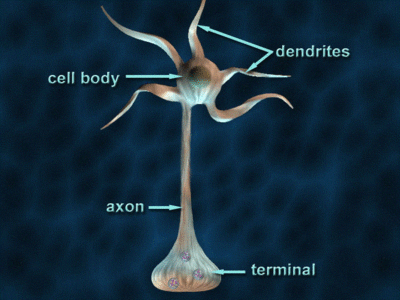
Axons are the elongated portion of the neurone located in the centre of the cell between the soma and axon terminals. Each neuron in your encephalon has an axon that snakes away from the principal function of the jail cell. Several times thinner than a human hair an axon is where electrical impulses from the neuron travel away to be received by other neurons.
- In size, the axon may represent over 95% of the total volume of the neurone. Axons greatly vary in length - many are just a millimetre or and so, but the longest ones, such as those that go from the brain downward the spinal cord, can extend for more than a metre.
- An axon typically develops side branches called axon collaterals, and then that one neuron tin send information to several others. These collaterals, similar tree roots, split into smaller extensions chosen terminal branches, with a synaptic last on the tip.[ane].
- Some axons are encased in a fatty substance called myelin (the encephalon's white thing). Myelin acts equally a form of insulation for axons, helping to transport their signals over long distances. For this reason, myelin is mostly establish in neurons that connect different brain regions, rather than in the neurons whose axons remain in the local region[2].
Axon vs Dendrite [edit | edit source]
The axon is one of two types of protoplasmic protrusions of the neuronal soma. The other protrusion is the dendrites. Axons are distinguished from dendrites by several characteristics including:
- Shape. Dendrites are ordinarily thin while axons typically maintain a constant radius
- Length. Dendrites are express to a small region effectually the cell body while axons tin can exist much longer
- Structure. Substantial structural differences exist between dendrites and axons. Eg only dendrites contain rough endoplasmic reticulum and ribosomes, and the construction of the cytoskeleton is different. Differences also bear upon the membrane as it contains mostly voltage-gated ion channels in axons, whereas ligand-gated ion channels are present, especially in dendrites.
- Functions. Dendrites commonly receive signals, while axons typically transmit them.[one]
Axon Collaterals [edit | edit source]
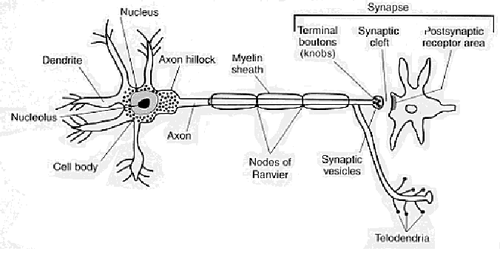
Each neuron has merely one axon however bifurcations, that are branches of the main axon, tin can exist present.
- A collateral branch is an axonal protrusion over10 micrometers in length.
- These collaterals provide modulation and regulation of the cell firing pattern and stand for a feedback system for the neuronal activity.
- The last part of the axon and collaterals tapers progressively.
- These parts are chosen telodendron and proceed with the synapse (synaptic knob or button) which represents the specialized structure that comes into contact with another neuron (soma, axon or dendrite), or muscle fiber.
- Axon extension and growth of new telodendrons (and synapses) are guided by several factors, including the nerve growth factor (NGF). The branching processes, in turn, play a part of fundamental importance in neuroplasticity, for instance, in cognitive processes such equally retentiveness and learning[1].
Myelin Sheath [edit | edit source]
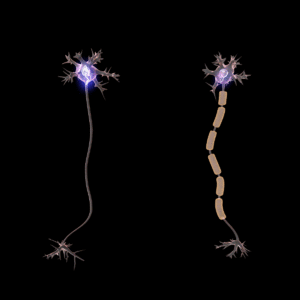
Myelin is a fatty substance that wraps around nerve fibers and serves to increase the speed of electrical communication between neurons.
Myelin is made by two different types of support cells.
- In the fundamental nervous organization (CNS) cells called oligodendrocytes wrap their branch-like extensions around axons to create a myelin sheath.
- In the nerves outside of the spinal cord, Schwann cells produce myelin.
- Regardless of where it is in the nervous organization, all myelin performs the aforementioned function, enabling efficient transmission of electrical signals[3].
- Demyelination is the term used to describe the destruction of the myelin sheath. This damage causes nerve signals to boring down or finish, resulting in neurological harm.
Paradigm: Myelinated neurons are faster than unmyelinated neurons considering of Saltatory motility.
Axon Hillock [edit | edit source]
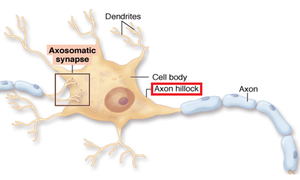
The axon hillock is a cone-similar part of the axon. This part of the axon has considerable functional importance since action potential originates here. In other words, this region of the neurolemma processes the incoming signals from other neurons. It represents a trigger zone where the summation of incoming graded excitatory (excitatory postsynaptic potentials, EPSPs) and inhibitory (inhibitory postsynaptic potentials, IPSPs) potentials are realized and, in turn, the action potential is realized or non. If the summation overcomes the threshold limit of the axon hillock, potential starts, and it will be transmitted, in a continuous or saltatory way, along the axon toward the synapse
Axonal Transport [edit | edit source]
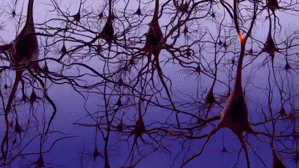
The axonal transport is of fundamental importance for the development, maintenance, survival, and functioning of neurons. This happens via molecular motors. The axon is devoid of the apparatus for protein synthesis and therefore is under the control of the cell trunk.[4]
- Axonal send is an free energy-dependent process that involves microtubules and the microtubule-based motor proteins, the dyneins and kinesins
- Metabolic demands of the axon involve a continuous movement from the cell torso forth the axon to its endings (of proteins, enzymes, chemical transmitters, synaptic vesicles, monomeric subunits of neurofilaments, and membrane components).
- In addition to the continuous exchange of the structural constituents of the axon, axonic flow is necessary to continuously supply the synapses of neurotransmitters and enzymes for their synthesis and degradation.
- Approximately, a volume of cytoplasmic constituents equal to three times the book of the prison cell body is transported daily along the axon.
- There are two types of axonal transport, a centrifugal transport from the soma to the synaptic final and a retrograde transport that specializes in carrying molecules from the nerve terminal to the soma[i].
Axonal Cytoskeleton [edit | edit source]
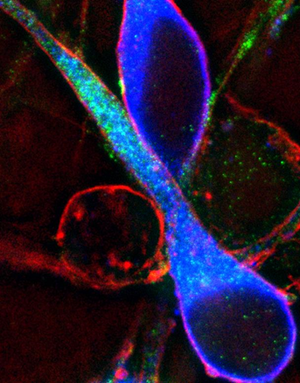
An important axonal structural element is the architecture of the cytoskeleton[ane].
Epitome: Fluorescence image of gonadotropin-releasing hormone expressing neurons ie cells in the brain that control the release of reproductive hormones from the pituitary (blue) with elements of their cellular cytoskeletons shown in red and greenish.
- The cytoskeleton plays a central role in the processes of axon growth and guidance. Since these processes are the basis of the formation of neural networks, at that place is considerable involvement in this aspect of neuroscience. Alterations during the constituent phases of the circuits are linked to the pathogenesis of neurodevelopmental disorders and neurodegenerative pathologies.
- Emerging evidence advise that the unique cytoskeleton organization in the axon is essential for its structure and integrity. In addition, the increasing number of neurodevelopmental and neurodegenerative diseases linked to defect in actin- and microtubule-dependent processes emphasizes the importance of a properly regulated cytoskeleton for normal axonal performance.[5]
- The neuronal cytoskeleton, composed of microtubules (MTs), actin filaments and neurofilaments, is not only required for axon germination and axonal transport but also provides the structural footing for several specialized axonal structures eg axon initial segment (AIS), located at the proximal axon and is the site of action potential initiation; presynaptic boutons (specialized area within the axon of the presynaptic cell that contains neurotransmitters enclosed in small membrane-bound spheres called synaptic vesicle).[1]
Pathophysiology [edit | edit source]
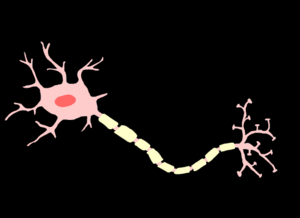
A large number of functional and/or structural alterations of the axon are at the basis of many neurological disorders that can involve the CNS or PNS. The evolution of targeted strategies confronting axonal impairment, or focused on axon regeneration, are of cardinal importance for the majority of all neurological diseases.
- Axon density, the caste of myelination, and regional size distribution are of fundamental importance for neural functioning.
- Structural and functional axonal alterations underlie neurological symptoms in a wide range of disorders such as stroke, traumatic encephalon, and SCI, peripheral neuropathies (e.g., diabetic neuropathy, CIPN), and chronic neurodegenerative (and neuroinflammatory) diseases such equally PD, MS, MND, and Alzheimer disease. eg In PD and MND, the axon and the presynaptic terminals are the first neuronal compartments to exist involved.[1]
Image: When the axon of a neuron in the PNS is damaged, retinoic acid stimulates a signal cascade to enhance axonal elongation.
References [edit | edit source]
- ↑ 1.0 1.1 i.2 1.three 1.4 i.5 1.half dozen Muzio MR, Cascella G. Histology, Axon.2020 Bachelor from: https://www.ncbi.nlm.nih.gov/books/NBK554388/(accessed 6.1.2021)
- ↑ QBI Axons Available from:https://qbi.uq.edu.au/brain/brain-anatomy/axons-cable-transmission-neurons (accessed 6.1.2021)
- ↑ Brain Facts Myelin Bachelor from:https://world wide web.brainfacts.org/brain-anatomy-and-office/anatomy/2015/myelin (accessed 6.1.2021)
- ↑ Ramachandran VS. Encyclopedia of the Man Brain, Four-Book Set. Academic Press; 2002. Available from: https://www.sciencedirect.com/topics/agricultural-and-biological-sciences/axonal-transport(accessed 6.1.2021)
- ↑ Frontiers in Molecular Neuroscience Cytoskeletonhttps://www.researchgate.cyberspace/publication/281393687_The_axonal_cytoskeleton_From_organization_to_function/fulltext/55e8e22808ae65b6389ae2ac/The-axonal-cytoskeleton-From-arrangement-to-role.pdf (accessed 6.1.2021)
Source: https://www.physio-pedia.com/Axons
Post a Comment for "From Where Can Collaterals Emerge on a Myelinated Nerve?"